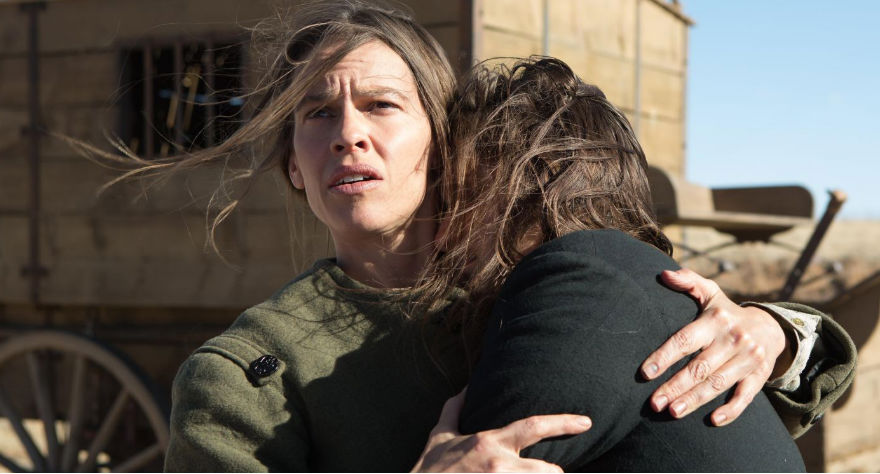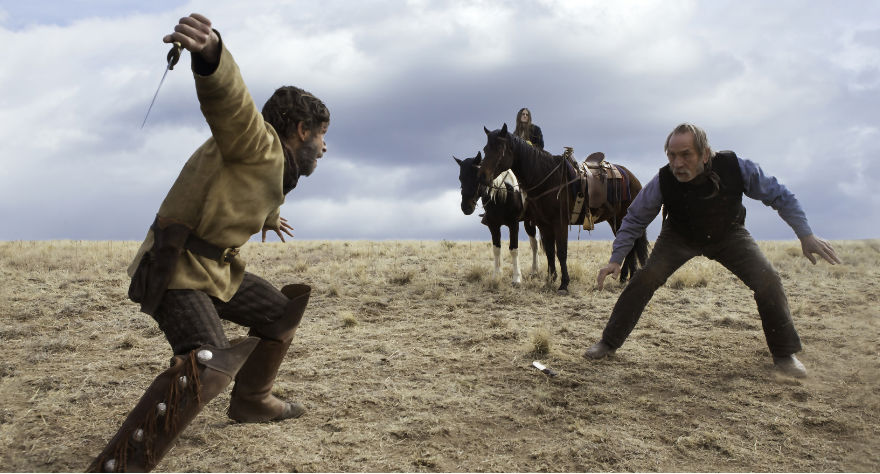
A feminist Western about lost souls and unanswered prayers that will rattle your soul.

A feminist Western about lost souls and unanswered prayers that will rattle your soul.
Strange, off-putting, sick in the head; these terms only begin to describe Tommy Lee Jones’ The Homesman. Troubling, thought-provoking, unpredictable…those fit, too. But they still aren’t enough. Jones’ second directorial effort is an elusive experience, difficult to pin down in many ways, though it comfortably belongs to the genre of Western. Here’s the most important thing I can say: What becomes of the film’s hero, a tough-willed frontierswoman by the name of Mary Bee Cuddy (played by a top-form Hilary Swank), left me stunned, confused, haunted, and sick to my stomach. Jones took me somewhere I didn’t want to be, somewhere deeply unsettling that; I find that admirable.
The story comes from a Glendon Swarthout novel, set in 1855 Nebraska. This isn’t a tall tale of cowboys with big guns, big britches, and big egos, but rather a solemn, contained story about a handful of sad, broken souls, bound together by circumstance. When we meet Cuddy (on her farm, which she built herself and takes pride in having done so), she’s dug herself into a sorry situation, offering her hand in marriage to a man over dinner. He calls her “plain” and “bossy” before hitting her with a stiff rejection. The townsfolk view Cuddy with much respect (though they too find her to be “plain” and “bossy”), and the local minister (Jon Lithgow) addresses her with particular admiration and thinks her work ethic and toughness make her as good a man as any. Why a “good man” and not a “good woman”?
The film’s commentary on gender inequity (an imbalance which tragically isn’t much different today than it was back then) is, like everything else in the movie, underplayed and largely expressed between the lines. In our eyes, as a modern audience, Cuddy is an extraordinary woman who has literally built a life for herself with her bare hands. To describe her as “plain” is laughable to (most of) us, but back then, women were only of interest if they fit a certain mold, looked a certain way, and fulfilled specific, “ladylike” societal requirements. Cuddy didn’t meet the requirements, so to everyone around her, she was of no interest. I think that’s what they mean by “plain”.

Cuddy’s entrusted with the task of transporting three mentally disturbed women across the frontier expanse between Nebraska and Iowa on a wagon to deliver them to a reverend’s wife. It’s a risky endeavor, even for the thick-skinned Cuddy, but just as she’s about to embark on the trek she comes across a man about to be hanged, the horse between his legs the only thing saving him from the noose. The man is a drunkard claim-jumper called George Briggs, who agrees to help Cuddy on her escort mission as payment for saving his sorry hide. We then follow the five travelers through the snowy, barren trails they hope lead to a better place, their minds and mettle pushed to the breaking point as madness slowly poisons them all.
Their journey isn’t exciting or full of grand heroic acts like the ones you’d find further West in John Ford’s Monument Valley; it’s full of sorrow, unanswered prayers, and bitter reality. Jones isn’t interested in pleasing crowds; the horrors the travelers encounter are grisly, blunt, and come at the most unexpected times. I found myself reeling every time the plot refused to go in directions that seemed most logical or convenient. Almost every plot twist and turn is an unpleasant one. One key revelation mid-film is an absolute knockout, its stark grotesqueness so shocking you could practically hear every jaw in the theater hit the floor.
That being said, the film is beautiful: the painterly landscapes are drop-dead gorgeous, and even though there’s a sense that doom lurks behind every tree and under every rock, there’s a strange, fatalist serenity to that. There are moments when the characters support each other (one in a river is tearjerking), but they fail each other more often.
The role of the cantankerous Briggs is right up Jones’ alley. Much like Jeff Bridges’ turn as Rooster Cogburn in the Coens’ True Grit, Jones’ Briggs is an unstable madman with more heart and moral fiber than you’re led to believe he has the capacity for. While there are some big names making brief appearances in the story’s periphery (Lithgow, Meryl Streep, and James Spader, all of whom do a fine job), Swank is the one who mesmerizes, the one who rips out your heart and tramples it. A fireside confession by a stripped-down Cuddy (literally and figuratively) to Griggs is so elegantly under-expressed that you won’t know what’s truly going on until it’s too late and you’re clobbered right in the gut. The way Swank slowly chips away at, then smashes Cuddy’s walls of strength into a pile of rubble, is inspired.
You could look at The Homesman as a subversion of the American West mythology, with most of the key narrative events pointing to the reality that the bad guys are more often then not rewarded for their crimes. Its more compelling form, however, is as a feminist Western, a sobering reminder of how little has changed in society since the dark days the story covers. The societal pressures put on the women on Cuddy’s wagon drove them to lose their damn minds. Are things really so different these days?